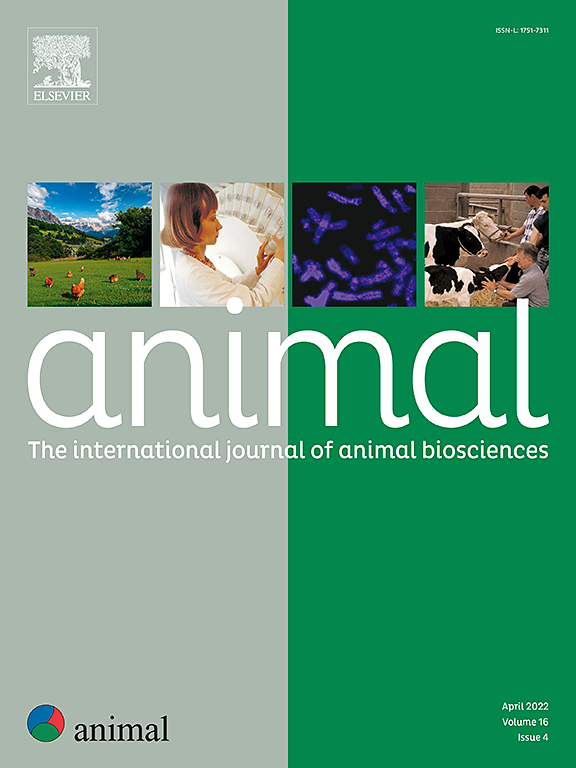Yellow mealworm: effects of adults breeding density on adults and larvae performances from an industrial perspective
IF 4
2区 农林科学
Q1 AGRICULTURE, DAIRY & ANIMAL SCIENCE
引用次数: 0
Abstract
A key aspect to optimise the Tenebrio molitor (TM) farm productivity is to find an optimal breeding density for adults. To this purpose, this study investigated, from an industrial perspective, the impact of four breeding densities (D1, D2, D3 and D4, equal to 0.8, 1.1, 1.3 and 1.6 adults/cm2, respectively) on mortality and reproductive performances of TM adults and larvae. Two weeks after pupae emergence, TM adults were randomly assigned to the four groups and housed in 48 breeding crates (60 × 40 × 14.5 cm; 12 crates/group). The trial consisted of 4 consecutive weeks of adult breeding (each week represented one oviposition), and 8 weeks of larvae growth. From each week of oviposition, a batch of larvae was obtained for a total of four batches of larvae (48 crates/batch). Larvae of each batch were grown until 8 weeks of age, corresponding to the period required to reach the selling size. Larvae were kept in the original crates until the 5th weeks of age, after which they were divided into additional crates to ensure a density of 4.2 larvae/cm2 and a final weight of 1 500 g of larvae/crate (0.6 g of larvae/cm2). For each oviposition week, TM adult’s mortality, egg hatchability, BW, feed intake, chemical composition and fatty acid profile were evaluated, while ovary weight was measured at weeks 1 and 4. The number of larvae was monitored at week 5 of age while their chemical composition was determined at week 5 and 8. Larvae feed intake and BW were monitored over the 8-weeks growth period. Individual feed intake and BW of adults increased with increasing breeding density (P < 0.0001 and P < 0.05, respectively). With increasing adult breeding density, the number of larvae per crate increased (P < 0.001) while the grams of larvae/gram of adults decreased (R2 = 0.8856). Larvae from groups D2, D3 and D4 showed higher feed intake per crate and higher individual and total final BW than D1 (P < 0.001). However, the feed conversion ratio (FCR) worsened with increasing breeding density (P < 0.001). D4 larvae had higher percentages of protein (P < 0.001), lipids (P < 0.05) and cholesterol (P < 0.001) compared to larvae from other groups. Concluding, a breeding density of 0.8 adults/cm2 maximised both grams of larvae produced/grams of adults and larvae FCR. However, breeding densities above 0.8 adults/cm2 resulted in a higher number of produced larvae per crate with a greater final mass weight making a density of 1.6 adults/cm2 the preferable choice from and industrial perspective.
黄粉虫:从工业角度看成虫繁殖密度对成虫和幼虫性能的影响。
优化褐飞虱养殖场生产力的一个关键方面是找到成虫的最佳繁殖密度。为此,本研究从工业角度出发,调查了四种繁殖密度(D1、D2、D3 和 D4,分别等于 0.8、1.1、1.3 和 1.6 成虫/平方厘米)对 TM 成虫和幼虫死亡率和繁殖性能的影响。蛹孵化两周后,褐飞虱成虫被随机分配到四个组,并饲养在 48 个饲养箱(60 × 40 × 14.5 厘米;12 个饲养箱/组)中。试验包括连续 4 周的成虫繁殖(每周代表一次产卵)和 8 周的幼虫生长。每周产卵一批幼虫,共四批幼虫(48 箱/批)。每批幼虫生长至 8 周龄,即达到销售规格所需的时间。幼虫在原来的板条箱中饲养到第 5 周龄,之后被分装到更多的板条箱中,以确保幼虫密度为 4.2 头/平方厘米,幼虫最终重量为 1 500 克/板条箱(0.6 克幼虫/平方厘米)。在每个产卵周,评估 TM 成虫的死亡率、卵孵化率、体重、饲料摄入量、化学成分和脂肪酸谱,并在第 1 周和第 4 周测量卵巢重量。第 5 周监测幼虫数量,第 5 周和第 8 周测定其化学成分。在 8 周的生长期间,对幼虫的饲料摄入量和体重进行了监测。成虫的个体采食量和体重随着养殖密度的增加而增加(P 2 = 0.8856)。与 D1 组相比,D2、D3 和 D4 组的幼虫每箱采食量更高,个体和最终总体重也更高(P 2 最大化了幼虫生产克数/成虫克数和幼虫 FCR)。然而,养殖密度超过 0.8 成虫/平方厘米时,每箱生产的幼虫数量更多,最终体重也更大,因此从工业角度来看,最好选择 1.6 成虫/平方厘米的养殖密度。
本文章由计算机程序翻译,如有差异,请以英文原文为准。
求助全文
约1分钟内获得全文
求助全文
来源期刊

Animal
农林科学-奶制品与动物科学
CiteScore
7.50
自引率
2.80%
发文量
246
审稿时长
3 months
期刊介绍:
Editorial board
animal attracts the best research in animal biology and animal systems from across the spectrum of the agricultural, biomedical, and environmental sciences. It is the central element in an exciting collaboration between the British Society of Animal Science (BSAS), Institut National de la Recherche Agronomique (INRA) and the European Federation of Animal Science (EAAP) and represents a merging of three scientific journals: Animal Science; Animal Research; Reproduction, Nutrition, Development. animal publishes original cutting-edge research, ''hot'' topics and horizon-scanning reviews on animal-related aspects of the life sciences at the molecular, cellular, organ, whole animal and production system levels. The main subject areas include: breeding and genetics; nutrition; physiology and functional biology of systems; behaviour, health and welfare; farming systems, environmental impact and climate change; product quality, human health and well-being. Animal models and papers dealing with the integration of research between these topics and their impact on the environment and people are particularly welcome.
 求助内容:
求助内容: 应助结果提醒方式:
应助结果提醒方式:


